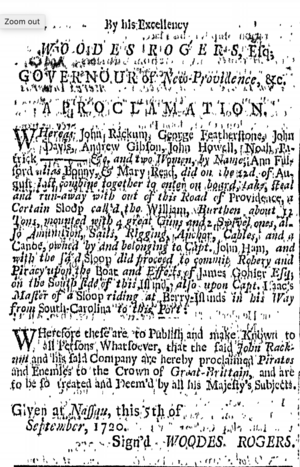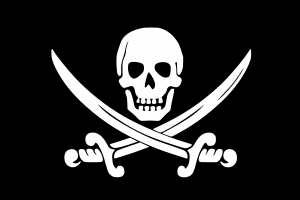Calico Jack facts for kids
Quick facts for kids
John Rackham "Calico Jack"
|
|
|---|---|

A woodcut of Rackham from Charles Johnson's 1725 edition of A General History of the Pyrates
|
|
| Born | 26 December 1682 |
| Died | 18 November 1720 (aged 37) Port Royal, Colony of Jamaica
|
| Spouse(s) | |
| Piratical career | |
| Nickname | Calico Jack |
| Type | Pirate |
| Years active | 1718–1720 |
| Rank | Captain |
| Base of operations | West Indies |
| Commands | Several vessels, most famously the Kingston (briefly) |
| Battles/wars | Capture of John "Calico Jack" Rackham |
John Rackham (born December 26, 1682 – died November 18, 1720) was an English pirate captain. He was known as Calico Jack because he often wore clothes made of a colorful fabric called calico. He sailed the seas around the Bahamas and Cuba in the early 1700s.
Rackham was active during the last years of the "Golden Age of Piracy" (1718–1720). He is famous for having two women on his crew: Mary Read and his partner, Anne Bonny.
He took over as captain from Charles Vane on the ship Ranger. Rackham then sailed through the Leeward Islands, Jamaica Channel, and Windward Passage. In 1719, he accepted a special offer from the King to stop being a pirate. He moved to New Providence, where he met Anne Bonny. In 1720, he went back to piracy by stealing a British ship, and Anne joined him. Their new crew also included Mary Read, who was pretending to be a man at the time. Rackham was captured later that year by Jonathan Barnet, a privateer. He was put on trial and hanged in November 1720 in Port Royal, Jamaica.
Contents
Becoming a Pirate Captain
We don't know much about John Rackham's early life. We know he was English and born around 1682. The first time we hear about him is in 1718. He was the quartermaster (a kind of second-in-command) on Charles Vane's ship, the Ranger. They operated from New Providence island in the Bahamas, which was a famous pirate base.
Vane and his crew robbed several ships near New York City. Then, they met a large French warship. This ship was much bigger than Vane's. Vane decided to run away from the fight. But Jack Rackham disagreed. He wanted to fight because the warship would have lots of treasure. Also, if they won, they would get a much bigger ship for themselves.
Most of the crew, about 76 out of 91 men, agreed with Rackham. But Vane said the captain's decision was final, and they fled. On November 24, 1718, Rackham held a vote. The crew decided Vane was a coward and removed him as captain. Calico Jack became the new captain. Rackham gave Vane and his 15 supporters another ship with supplies.
Adventures as Captain Rackham
Once he was captain, Rackham mostly robbed smaller ships close to shore. He and his crew captured a small Jamaican ship called the Kingston. They made it their main ship. They had several victories in the West Indies, taking a few large ships near Bermuda.
In 1719, Rackham sailed to Nassau. He took advantage of a special offer from the King to pirates. If they stopped pirating, they would be forgiven. Governor Woodes Rogers had been sent to the Bahamas to deal with pirates.
In December, Rackham captured a merchant ship also named Kingston. It had valuable goods, which was a big win for his crew. But the ship was taken near Port Royal. Angry merchants sent bounty hunters after him. They found him in February 1719, while his ship and the Kingston were anchored off Cuba. Rackham and most of his men escaped by hiding in the woods. But their ship and the captured Kingston were taken away.
Captain Charles Johnson wrote about how Rackham stole a ship in his 1724 book, A General History of the Pyrates. Rackham and his men were fixing their small ship in a Cuban town. A Spanish warship, which patrolled the Cuban coast, came into the harbor. It had also captured a small English ship. The Spanish warship saw the pirates but couldn't reach them because the water was low. So, they waited at the harbor entrance until morning.
That night, Rackham and his men rowed to the captured English ship. They took over from the Spanish guards. As dawn broke, the warship started firing at Rackham's old, empty ship. Meanwhile, Rackham and his crew quietly sailed away in their new prize.
Rackham and his men went back to Nassau. They told Governor Rogers that Vane had forced them to be pirates. Rogers didn't like Vane, so he believed them. He gave them the King's pardon, allowing them to stay. But they didn't stay honest for long.
Anne Bonny Joins the Crew
While in port, Rackham started a relationship with Anne Bonny. She was married to a sailor named James Bonny, who worked for Governor Rogers. Anne decided to leave her husband and run away with Rackham.
The two of them, with a new crew, escaped to sea. They stole a ship belonging to John Ham. This meant Rackham's pardon was no longer valid. They sailed the Caribbean for two months, taking over other pirate ships. Rackham often invited the crew of ships he attacked to join his own. Anne became pregnant and went to Cuba to have her child.
Capture and Trial
In September 1720, Governor Woodes Rogers announced that Rackham and his crew were pirates again. This announcement was published in October 1720. After this, a pirate hunter named Jonathan Barnet and a former pirate named Jean Bonadvis began to chase Rackham. Rackham was sailing near Jamaica, capturing small fishing boats and scaring fishermen.
Rackham and his crew were sailing west, towards Negril. Around October 31, 1720, Rackham's ship was anchored. They fired a gun, which caught the attention of Jean Bonadvis's ship. Bonadvis told Barnet, who sailed to check out the ship. At 10 PM, Barnet called out to the ship, asking who they were. The reply was "John Rackham from Cuba." Barnet immediately told them to surrender. Someone on Rackham's ship fired a small cannon at Barnet's ship. Barnet then ordered his ship to fire all its cannons. This damaged Rackham's ship, and his crew surrendered.
Barnet took the men ashore at Davis's Cove near Lucea, Jamaica. There, a military officer named Major Richard James arrested them. Rackham and his crew were taken to Spanish Town, Jamaica, in November 1720. They were tried and found guilty of piracy. They were sentenced to be hanged.
Rackham was executed in Port Royal on November 18, 1720. His body was then put on display on a small island at the entrance to Port Royal. This island is now known as Rackham's Cay.
Fate of the Crew
Anne Bonny and Mary Read both said they were pregnant during their trials. This happened ten days after Rackham was executed. Because of this, they were given a temporary delay in their execution. They were held in Fort Charles until their claims could be proven. Mary Read died in her cell in April 1721, likely from a fever related to childbirth. There are no records about what happened to Anne Bonny after that.
Several other crew members were executed with Jack Rackham in Port Royal. These included George Fetherston, Richard Corner, John Davis, and John Howell. The next day, Patrick Carty, Thomas Earl, James Dobbin, and Noah Harwood were executed in Kingston.
The Jolly Roger Flag
The flag often shown with Rackham has a white skull above crossed swords on a black background. Some people think Rackham invented or designed this famous Jolly Roger flag. However, during his trial, no one said they saw Rackham use such a flag. They only said his ship flew "a white pendant" (a long, narrow flag).
The skull-and-crossed-swords design probably became popular in the early 1900s. Connecting it to Calico Jack likely started with a book written in 1959 by Hans Leip.
See also
 In Spanish: Jack Rackham para niños
In Spanish: Jack Rackham para niños




